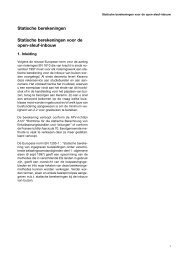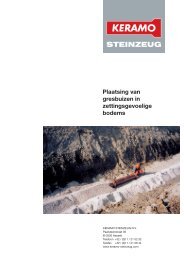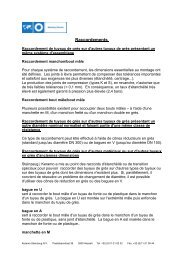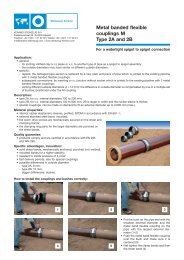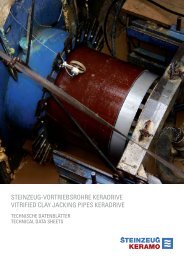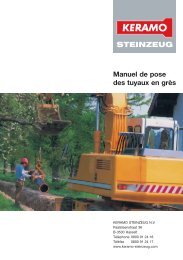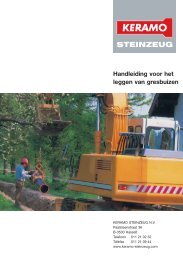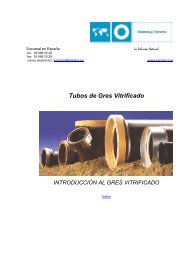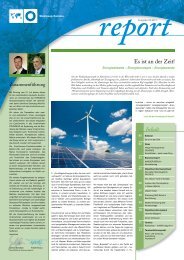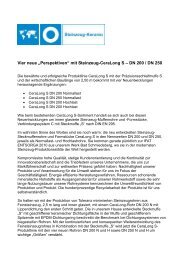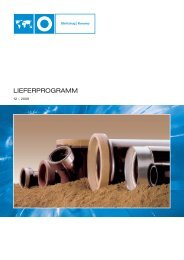mohring engels.indd - Keramo Steinzeug
mohring engels.indd - Keramo Steinzeug
mohring engels.indd - Keramo Steinzeug
Create successful ePaper yourself
Turn your PDF publications into a flip-book with our unique Google optimized e-Paper software.
Fig. 18: Starting shaft<br />
(3.20 metres) with shield jacking<br />
of DN 500 vitrified-clay pipes<br />
For nominal sizes greater than DN 800 rectangular shafts<br />
must generally be dug. Alternatives for all nominal sizes<br />
are starting shafts of reinforced shotcrete, which lend<br />
themselves well to confined spaces, or the ONE-PASS<br />
SHAFT LININGS from England. The latter are prefabricated<br />
concrete tubbings which can be assembled on<br />
site, are available in a variety of bores from 1.52 to 10.67<br />
metres and are reusable.<br />
The shafts needed for thrust boring road sewers are also<br />
the starting point for thrust boring house connections,<br />
which are thrust bored to the plots in a radial way. If the<br />
shafts are arranged carefully according to local conditions,<br />
several plots can be reached from one shaft without<br />
any overlength arising for the particular house connection<br />
or need to tunnel under other plots.<br />
In the Berlin method type I the plots which cannot be<br />
reached from the starting or target shafts are<br />
accessed – also radially – from sunk ”by-shafts”. In the<br />
by-shaft the feeder-sewers are linked to the collector by<br />
backdrops and fittings. If the collector is above the<br />
groundwater, the by-shaft is sunk using liner-plate rings<br />
after thrust boring of the collector has been completed<br />
and retracted for re-use when the house connections<br />
have been constructed (Fig. 19). If the collector is in the<br />
groundwater, prefabricated reinforced-steel shafts are<br />
used for the by-shafts and sunk before any thrust boring<br />
starts. Like the starting and target shafts, they are<br />
sealed watertight under pressure under the sewer bottom<br />
with an concrete seal preventing buoyancy.<br />
Micro-tunnelling Page 17<br />
Pipe jacking then takes place through prepared apertures<br />
with collar seals against the pressing groundwater<br />
from the starting to the target shaft, through the byshafts<br />
which remain in the soil (Fig. 20). In the final cycle<br />
the starting and target shafts are finished as manholes<br />
with the usual dimensions.<br />
In the Berlin method type II the ”by-shafts” are replaced<br />
by additional starting, target or intermediate shafts<br />
linked radially to the house connections; when construction<br />
is completed, these become ordinary manholes into<br />
the sewer system (Fig. 17). This version meets the requirement<br />
in ATV A 142 that in Protected Zone II waterprocurement<br />
areas all feeder-sewers must be -connected<br />
to access-hole structures.<br />
The usual alternatives for finishing/converting the<br />
starting, target and intermediate shafts as/to ordinary<br />
manholes into the sewers are evident from Fig. 17 in<br />
conjunction with the diagrams in Fig. 21 to 23.<br />
Fig. 19: Berlin method: by-shaft above groundwater table





